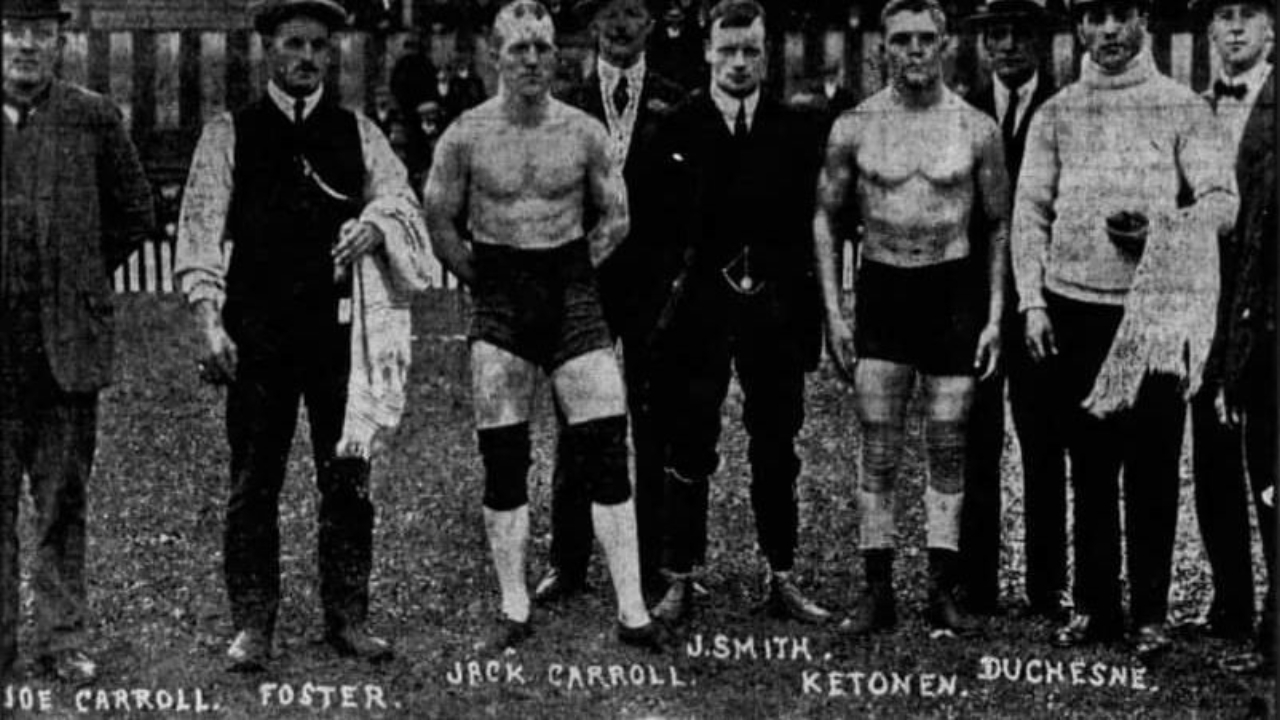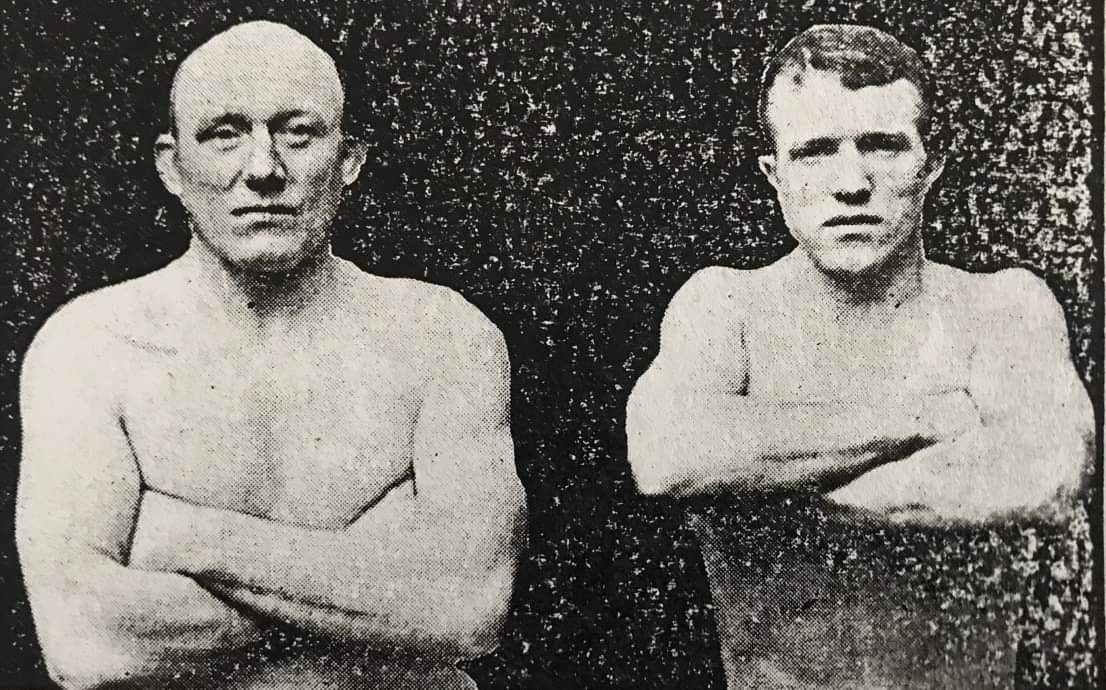Waino Ketonen Challenges the Lancashire Wrestlers 1911


Photo: Waino Ketonen
By Mark S. Hewitt
In the late summer of 1911, Waino Ketonen invaded England to challenge the Lancashire wrestlers and further solidify his claim to the welterweight crown. Ketonen was accompanied by Tom Duchesne and their manager Edward Levasseur. Ketonen, though originally from Finland, and Duchesne were leading exponents of the rough-and-ready North American-style professional catch-as-catch-can wrestling. They were bringing their grappling skills to the cradle of catch wrestling-Lancashire County in North West England. On behalf of Ketonen, Levasseur issued an open challenge that the Finn could throw any British welterweight 2x in an hour, or any middleweight in a two-out-of-three falls contest. They were ready to put up wagers to back their boasts.
Duchesne, from Fall River, MA had toured Britian the previous year and brought home first place honors in a Welsh tournament. This time, Ketonen was the star and Duchesne was along mostly as a training partner. Ketonen competed in four bouts, all wrestled in the traditional Lancashire fashion-open air and on the ground, and with side bets posted. He defeated Jack Bailey, Jack “Whistler” Carroll and Tom Pearce. Duchesne engaged in one match, losing to Tom Rose, “the Pet of Lancashire.” Rose had agreed to face Ketonen, if he first beat Duchesne. Though winning, Rose had suffered an injured shoulder and declined to meet Ketonen. Carroll and Rose both had claims to the welterweight championship and Ketonen had hoped to conquer them both before returning to the US.
Ketonen lost his fourth match, dropping an unpopular decision to Jim Foster. The latter was heavier than the welterweight class, so they wrestled at catchweights. Ketonen had become popular among the local mat fans and was favored in the heavy betting 7-4. The pair met over three 30-minute periods with no falls registered. The referee awarded the contest to Foster on points, and was soundly booed by the crowd.

Photo: Joe Carroll (left) and his nephew, Jack "Whistler" Carroll (right)
The touring American troupe returned home in early October and Ketonen sported an ornate trophy belt, announced as representing the welterweight wrestling championship of the world. The claim was based on his victory over Carroll and awarded by the Sporting Chronicle, the leading British sporting periodical of its day. Ketonen had defeated “Whistler” in two straight falls with double-elbow holds, 6:35 and 3:00 respectively. They met at 148 pounds ringside. According to Sporting Chronicle rules they would contend with a one hour, 40-minute time limit; two out of three falls.
Duchesne’s hometown newspaper reprinted a description of the Ketonen/Carroll contest from the Sporting Chronicle. It captures what a traditional Lancashire catch wrestling match would have looked like. Here are the highlights, “Carroll faced his man hands extended and twice changed his mind about getting hold at his head, as the Finn seemed desirous of seizing the arm. Ketonen wrestled low, and pawed in an unorthodox, grabbing fashion. ‘Whistler’ closed at the head, and appeared the stronger, and the other palpably failed when trying to convert Carroll’s swinging arm into a front elbow. Carroll got away somewhat easily, and following up his success, dashed at his man, and went under for a leg in the usual fashion. Getting behind, Carroll worked for a near ankle, and tried to lever the foot up the back…Carroll, threading the near arm halch fashion, pulled his man to him, and a roar went up as he waited his turn to ‘bridge.’ A desperate whirl ensued, and Carroll once gave his man a decent bump as he was bridging, but it made not the slightest impression, and as the Finn cleared the Wigan lad refused to wrestle back, and got up.
After several rather wild grabs to get at the legs by Ketonen, Carroll carelessly missed his distance for a step back, and a second follow-up secured an ankle for Ketonen. Carroll turned and tried to tear out, but the tight hold by Ketonen brought Carroll flat to the ground…Carroll got up strongly, but the other hung on, and pinning Carroll’s right arm to his body, pulled him down. Again ‘Whistler’ got up…Having his man in position for ordinary aggressiveness a la Lancashire, the Finn went to work in a far different manner than most would…to secure a front elbow whilst wrestling behind. Gathering ‘Whistler’s’ near arm…he made a halch of it, and pushed Carroll away from him on to the side, using the halch as a lever. When Carroll was half over the Finn stopped, and loosened Carroll’s arm. His next move was stranger still, for instead of making the most of the position to finish his man, he half stopped, and as Carroll was righting himself the other seized the wrist that Carroll was lying on, turned out as if to face his man, and as the other straightened his arm to get up, the Finn tucked the elbow well under his other, and took Carroll front elbow hold, but with his man across his neck. Carroll went on one shoulder, and bridged manfully, and although the arm was as in a vice, Carroll worked his body well, but each time was met with the angling of the Finn’s body. Three times the Wiganer ‘bridged’ just as he was about to touch the second shoulder, and Carroll tried to use his disengaged arm, but a moment later Ketonen shifted to the front as he secured the second elbow. Carroll bridged again, but although he put up a strong resistance he was thrown…The second meeting was even more brief, Carroll’s undoing being his willingness to wrestle. He was twice at the back, and in a rally that followed Ketonen appeared to work ‘oxter’ holds upside down, and then twist his body under his man and make ‘elbows’ that were not there, and as one spectator remarked, ‘You never knew you were in them until you knew you knew you could not get out.’ Carroll though in the toils bridged…until he was pressed down, thoroughly exhausted…Though fearfully disappointed at what he considered his miserable showing, Carroll shook hands, having to admit he had met a better man.” (Fall River Evening Express, 9/8/1911)
Note that the crowd of nearly 3,000 stayed glued to all the ground grappling hold-for-hold and followed every move and counter-move. They appreciated the display of scientific wrestling. Lively betting continued throughout the contest with the odds changing several times. Ketonen was particularly known for his double-elbow hold. Toeholds and other submission holds, though featured in American matches, were not in use among the Lancashire wrestlers of the time. Lancashire-style bouts were won with “fair back falls”-by pinning an opponent. The older rough and tumble style, derived from Flemish Up and Down Fighting had been cleaned up and sanitized. Veteran catch wrestler Tom Connors recalled that “the magistrates of Lancashire prohibited such unfair methods. I for one, remember three men being killed by the choke hold and double-nelson.” (Manchester Evening News, 3/24/1905)
The Lancashire wrestlers’ wild and wooly North American contemporaries however incorporated any and all holds, usually but not always only barring strangles and chokes. They went after a win by pin or by concession. Ketonen demonstrated that he was a consummate wrestler and could compete under any rule-set.
The 1911 Ketonen English Tour:
7/30/11-Waino Ketonen beat Jack Bailey
8/26/11-Wigan, England-Waino Ketonen beat Jack “Whistler” Carroll
9/4/11-Bolton, England-Tom Rose beat Tom Duchesne
9/9/11-Jim Foster beat Waino Ketonen
*Ketonen also defeated Tom Pearce
Mark S. Hewitt/Combat Sports Research 2023

